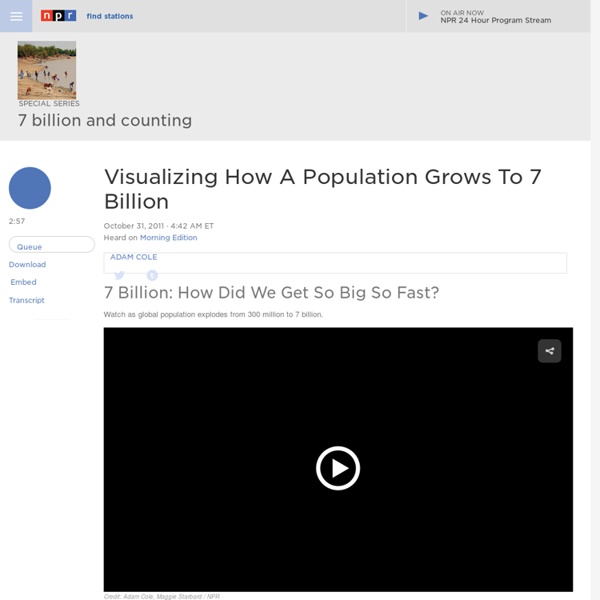Free Resources
Close If you are trying to view the videos from inside a school or university, your IT admin may need to enable streaming on your network. Please see the Internet Filtering section of our Technical Requirements page. DVDs AND OTHER COPIES Videos on this page are not available on DVD at this time due to licensing restrictions on the footage. Subscribers to NBC Learn may download videos and play them back without an internet connection. Still have questions? The Science of the Olympic Winter Games videos are only available to visitors inside the United States due to licensing restrictions on the Olympics footage used in the videos. The Science of the Olympic Winter Games is not available on DVD at this time due to licensing restrictions on on Olympic footage.
Virtual Water - Discover how much WATER we EAT everyday
The good news is that each one of us can also make the world a little more water secure, ready to face the needs of our peak population future. How? The answer lies in our shopping baskets. The amount of meat in our diet is crucial! The average daily water consumption of a meat-eating person is 5000 litres of water per day. The type of meat we consume is crucial! The food we waste is crucial! So, do not forget: one meat-free-day a week choose meat raised on grass do not waste food
Evolución de la Población
3. Evolución de la población. 3.1 Evolución histórica de la población. A lo largo de la historia la evolución de la población no ha llevado siempre el mismo ritmo de crecimiento que hay actualmente (Gráfico 3). Una vez establecidos estos cambios, la población se estanca, creciendo con altibajos y muy dependiente de las catástrofes naturales y humanas como epidemias, malas cosechas, guerras, etc. No es hasta el inicio de la edad moderna cuando la población comienza un ligero aumento, llegando a los seiscientos millones en el año 1600, siendo aun un crecimiento catastrófico. El segundo momento histórico importante para el crecimiento de la población lo encontramos durante la Revolución Industrial. Gráfico 3.
Mediarena 2012
Circulatory System
Circulatory System for Kids The human circulatory system consists of vessels, muscles and organs that help and control the flow of the blood and lymph around the body. It is collectively composed of the cardiovascular system and the lymphatic system with the heart, arteries, capillaries, veins and the blood being the main parts. The circulatory system moves nutrients, gases, and wastes to and from cells to maintain homeostasis. It helps fight diseases, maintains body temperature and pH. Play Quiz Games : NeoK12 is iPad & Android tablet ready. Science Games, Diagrams & Activities : Pictures & School Presentations : Science Videos & Lessons:(Reviewed by K-12 teachers) Search Videos Suggest Science Videos Click below to find & suggest other science videos. Topic : Circulatory System Standards Common Core State Standards Videos are embedded and streamed directly from video sites such as YouTube and others.
Le budget métropolitain
Le conseil d'agglomération a adopté, le 18 décembre, le budget 2015 de Rennes Métropole. Ce budget historique de 829,7 M€ est marqué par d'importants investissements, notamment pour la ligne b, et par le passage en métropole. Le détail en infographies. Le budget 2015 a été adopté par le conseil communautaire le jeudi 18 décembre 2014. 463,88 M€ d'investissements Le principal fait marquant de ce budget est l'investissement. Les dépenses et les recettes en 2015
El neolític | La prehistòria
El Neolític va ser una època en que els homes prehistòrics van descobrir moltes coses que els ajudaren a viure millor. Anem a conèixer com va anar canviant la seva vida. Quan comença El neolític comença fa 10.000 anys abans de Crist. La vida de l’home neolític Com que eren sedentaris, vivien en cabanes, i en petits poblats. L’alimentació Els homes i les dones del Neolític, s’alimentaven principalment de les plantes que conreaven: cereals (blat, civada, sègol, ordi…) llegums (llenties, ciurons, pèsols…); encara que no van deixar de recol·lectar fruits silvestres. Sergio de la Rosa i Qamar Les seves eines. La destral: L’utilitzaven per construir cabanes i estava fet de fusta i de pedra. La falç: S’utilitzava per tallar el blat i estava fet de fusta i dents Les pales: s’utilitzava per fer forats a la terra i estava fet de fusta. Aixada: S’utilitzava per cavar la terra i estava feta de pedra i de fusta. Molins de mà: s’utilitzava per moldre el gla i estava fet de dos pedres. Raúl Pérez Boyer
HarassMap
What's Really Warming the World? Climate deniers blame natural factors; NASA data proves otherwise
Climate scientists tend not to report climate results in whole temperatures. Instead, they talk about how the annual temperature departs from an average, or baseline. They call these departures "anomalies." The simulation results are aligned to the observations using the 1880-1910 average.



